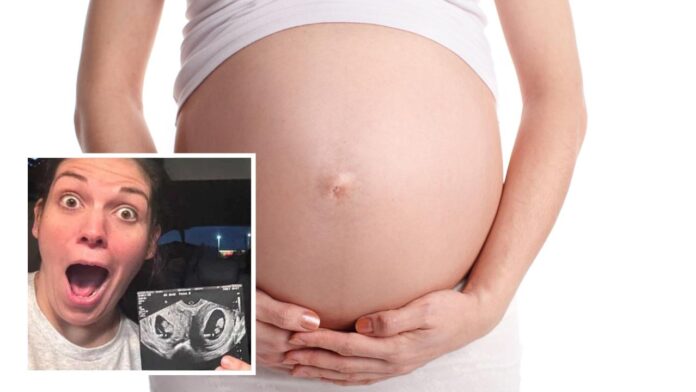[ad_1]
An Alabama mum is pregnant in both of her two uteruses at once, in an extremely rare case of twins.
Kelsey Hatcher, 32, discovered she was pregnant in the same way many others do — she missed her period.
From there, a home pregnancy test turned positive and the mum-of-three broke the news to her husband, Caleb.
“When I told him I was pregnant again, he’s like: ‘OK, well, what’s one more? It’ll be great. It’ll be fine,’” she told CNN.
But at Ms Hatcher’s eight-week ultrasound, the couple discovered they will be welcoming not just one new baby, but two.
More likely to win the lottery
Ms Hatcher was born with a rare condition called uterine didelphys. The condition means a person is born with two uteruses, and sometimes two vaginas and cervixes, as well.
She informed her ultrasound tech of her condition, and the tech quickly found one baby and confirmed it was healthy.
“As soon as she moved the ultrasound wand over to the other side of my belly, I said: ‘Oh, my gosh! There’s another one,’” Ms Hatcher recalled.
“The nurse practitioner that I met with that day, she was just blown away. She said, ‘I’m not even sure what the statistics of this are.’”
The odds, it turns out, are exceptionally unlikely.
About 3.6 million babies were born in the US last year, and about 114,000 of those births were twins, according to the US Centers for Disease Control and Prevention.
Ms Hatcher’s condition is rare, too, affecting about 1 in 2000 women.
Furthermore, in order for her to have become pregnant in both uteruses at once, one egg must have been fertilised in each womb.
That’s possible because, like most women, Ms Hatcher has two ovaries, though for her, one feeds each uterus.
Occasionally, the ovaries will release multiple eggs in one cycle. That’s also rare, occurring in about one in five women, according to one study. Occasions when each ovary releases an individual egg are even rarer than that.
With all of those odds in mind, one case study estimates the chance of a pregnancy like Ms Hatcher’s at about one in two billion.
That means Ms Hatcher was about seven times more likely to win a Powerball jackpot and 131,000 times more likely to be hit by lightning during her life.
In reality, it happens so infrequently that the likelihood is difficult to calculate at all.
Two baby bumps
Both babies are girls and, at 34 weeks, are growing well.
They’re due to be born on Christmas Day, though Ms Hatcher knows making it to term is less likely with twins.
The couple said they were prepared to go to the hospital at any moment. Their bags are packed and a GoFundMe has been launched to help with unexpected expenses.
“The Hatchers are living out their miracle right in front of your eyes,” the fundraiser, which was started by a friend, reads.
It says the cash will help the incoming family-of-seven take time off work, buy a bigger car and renovate their home to accommodate five kids.
Bizarrely, in some positions, Ms Hatcher says she even has two baby bumps.
When she lies back in her recliner, for instance, “the girls will separate, almost, and you can see vividly the two separate wombs, because there’s a big gap in my stomach where they fall to one side or the other,” she said.
‘Birth is the biggest unknown’
Uterine didelphys happens in the first weeks of a baby’s development. Female babies develop with two uterine horns, or halves, that usually fuse to form one large womb. With uterine didelphys, that fusion doesn’t occur.
Some women with the condition only have one functional uterus, but Ms Hatcher’s medical records show she has carried babies in both of hers, just never before at the same time.
“Even in medical school, we don’t really learn about this because this is such a rare thing,” Shweta Patel, Ms Hatcher’s obstetrician at the University of Alabama at Birmingham, told CNN.
Dr Patel said birth is “probably the biggest unknown”, with Ms Hatcher’s medical team unsure whether labour will begin in both uteruses at the same time or whether a C-section will be possible.
“We won’t know until we see it,” Dr Patel said.
The couple has embraced the uncertainty and says they’re excited to welcome their two girls.
“There’s no denying the miracle in these babies and knowing that they are here for something great, because for all of that to line up perfectly and it to happen the way that it has, you can’t question that, you know?” Ms Hatcher said.
[ad_2]
Source link


